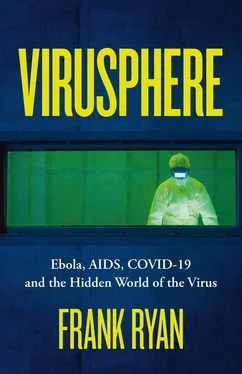In 1926, d’Herelle published a now-historic book, The Bacteriophage , in which he described his work, and thoughtful extrapolations, concerning bacteriophage viruses. As we shall duly discover, the importance of the bacteriophage, as we recognise it today, has eclipsed all that even its pioneering researcher, Félix d’Herelle, could possibly have imagined in those early years.
In retrospect, it is remarkable that, even so many decades ago, d’Herelle clearly grasped that he was dealing with a wonder of the natural world, declaring in his book that these agents that were so dreadfully lethal to bacteria were also capable of exerting an extraordinary balancing effect in the interactions between the bacteriophage virus and its host bacterium. In his words: ‘A mixed culture results from the establishment of a state of equilibrium between the virulence of the bacteriophage corpuscles and the resistance of the bacterium. In such cultures a symbiosis obtains, in the true sense of the word: parasitism is balanced by the resistance to infection.’ This is the first use of the term ‘symbiosis’ in reference to viruses in microbiological history. In a footnote, d’Herelle took the implications further by drawing a parallel between what he was observing in the interaction of the bacteriophage virus and bacterium and the symbiosis that had recently been discovered in all land plants, where fungi in soil invade the plant roots to form a ‘mycorrhiza’, whereby the fungus feeds the plant with water and minerals and the plant feeds the fungus with the energy-giving metabolites that derive from the photosynthetic capture of sunlight. In d’Herelle’s words: ‘The respective behaviour between the bacterium and the bacteriophage is exactly that of the seed of the orchid and the fungus.’
D’Herelle is now recognised by many scientists as the father of both virology and molecular biology. But it would take many years before the world of virology, and microbiology in general, would come to rediscover d’Herelle’s original vision of the symbiotic nature of the bacteriophage.
4 4. Every Parent’s Nightmare 5. A Bug Versus a Virus 6. A Coincidental Paralysis 7. Deadly Viruses 8. An All-American Plague 9. Lurker Viruses 10. How Flu Viruses Reinvent Themselves 11. A Lesson from a Machiavellian Virus 12. The Mystery of Ebola 13. The Mercurial Nature of the Zika Virus 14. A Taste for the Liver 15. Warts and All 16. Lilliputian Giants 17. Are Viruses Alive? 18. Inspiring Terror – and Delight 19. The Ecology of the Oceans 20. The Virosphere 21. The Origins of the Placental Mammals 22. Viruses in the Origins of Life 23. The Fourth Domain? Bibliography and References Index About the Book About the Author Also by Frank Ryan About the Publisher
Every Parent’s Nightmare Contents Cover Title Page Copyright Dedication Epigraph Introduction 1. What Are Viruses? 2. Coughs and Sneezes Spread Diseases 3. A Plague Upon a Plague 4. Every Parent’s Nightmare 5. A Bug Versus a Virus 6. A Coincidental Paralysis 7. Deadly Viruses 8. An All-American Plague 9. Lurker Viruses 10. How Flu Viruses Reinvent Themselves 11. A Lesson from a Machiavellian Virus 12. The Mystery of Ebola 13. The Mercurial Nature of the Zika Virus 14. A Taste for the Liver 15. Warts and All 16. Lilliputian Giants 17. Are Viruses Alive? 18. Inspiring Terror – and Delight 19. The Ecology of the Oceans 20. The Virosphere 21. The Origins of the Placental Mammals 22. Viruses in the Origins of Life 23. The Fourth Domain? Bibliography and References Index About the Book About the Author Also by Frank Ryan About the Publisher
Parents will be familiar with the anxiety that comes with childhood rashes and fevers. How natural that our hearts should falter with the beloved child tossing in a perspiring fever, the restless anxiety, racking coughs, or sickness and vomiting. We can hardly sleep with worry that something worse might happen in the dark of night. That worry is, perhaps, a residuum of a fear from times only recently gone by when unpleasant things really did happen in the dark of night to those we loved. How fortunate we are now that our families are protected by antibiotics, antiviral drugs and the vaccines that keep such terrors at bay. But these advances are relatively new to medicine and to society. We should not forget that as recently as the 1950s most of humanity, even in developed countries, ultimately died from infection.
Before its prevention, using the triple vaccine, one such major cause of parental anxiety was measles, a commonplace and highly contagious childhood fever. How astonishing it is that this appears to be a relatively new disease in humans. Hippocrates, who wrote about the common diseases in Ancient Greece in the fifth century CE, recorded clearly recognisable descriptions of common infections such as the virus-caused herpes and the protist-caused malaria, yet this very knowledgeable ancient authority gave no description to match the symptoms and signs of measles. It is hardly a disease that would be readily missed, with its striking rash and fever, high contagion and common association with childhood. There is a clue in the name, ‘measles’, deriving from an Anglo-Saxon word maseles , which means ‘spots’. The first written description of measles is attributed to the tenth-century Persian physician, Abu Becr, also known as Rhazes, who cited a seventh-century Hebrew physician, El Yehudi, as providing the first clinical description of the disease. Rhazes recognised measles as an affliction of children and he distinguished it from the equally prevalent but far deadlier rash-provoking disease of smallpox.
Symptoms typically include a high fever, with a temperature often greater than 40°C, a racking cough, runny nose and inflamed eyes. Two or three days after the start of the fever, small white spots on a red inflamed background can be seen in the mucous membranes inside the cheeks. These are known as Koplik’s spots and are diagnostic of the disease. At much the same time a flattish, bright red rash invades the skin, usually beginning on the face and then spreading to the rest of the body. The rash, and causative illness, usually persists for seven to ten days and, in fit and well-nourished children, is usually followed by a full recovery. But in a minority of cases, most commonly seen in malnourished children, and in particular children in less-developed countries with poorly developed health care facilities, measles can lead to serious complications.
Like the common cold, measles is specific to humans, although it can be artificially transmitted to monkeys by laboratory experiment. This means that we are the reservoir of measles in nature – we are the natural host. The only place measles virus can spread its infection, and produce its new brood of new daughter viruses, is in us. It really is that up close and personal. And this means that the relationship – the symbiosis – between humans and the measles virus has been evolving for a long time, and in symbiological parlance with evolutionary implications for both ‘partners’. The causative virus, or morbillivirus, comes in a variety of groups, known as ‘clades’, within the broader family of viruses, called the paramyxoviruses. Individual measles virions are spherical, rather like cold viruses, with a genome made up of a single strand of RNA. The viral genome is contained within a similar capsid type of coat, but in this case the capsid is enclosed in an additional surface ‘envelope’, which carries multiple spike-like projections that play a key role in the infectious process.
Measles is a highly infectious virus with a worldwide distribution, but it can only survive in populations as an ‘endemic’ contagion, in populations where there is a continuous supply of susceptible children. We shall return to this observation when talking about the measles vaccine. The measles virus spreads by aerosol inhalation, much like the common cold. Its initial target cells are, once again, the lining cells of the respiratory tract. But unlike the cold virus, with its focus on the nose and throat, measles heads down into the lower respiratory tract. For some unknown reason, the virus also has a predilection for the cells of the conjunctivae, which explains the inflamed eyes that are a common sign of the clinical presentation. During the first two to four days of infection, the virus multiplies locally in the target cells. The alien presence of the virus provokes local inflammation and this in turn attracts the attention of white blood cells, known as macrophages, which normally gobble up unwanted debris, dead and diseased cells and invading parasites. This process is known as phagocytosis. Unfortunately – or alas perhaps knowing a little about viruses and their behaviour, predictably – these same phagocytes now become the final target cells of the measles virus.
Читать дальше












